Running a business is all about having a set of solid communication skills.
On the one hand, you have potential customers you need to attract with a clear, compelling message tailored to the audience about your company’s strategy, customer service, and brand identity.
On the other hand, knowing how to convey information in the workplace is no less critical, as thoughtful communication is a must-have to ensure effective teamwork and collaboration within and between your teams.
Any organization thrives on employees who can express themselves clearly and understand the company’s vision, and it’s no wonder why. Strong business communication skills lead to a more productive environment, which also helps you:
- Accelerate your business success by achieving the set goals
- Build professional relationships
- Boost customer satisfaction
- Improve your teamwork
- Enhance team performance
- Avoid disputes and misunderstandings
- Give and receive precise feedback
- Encourage innovative thinking
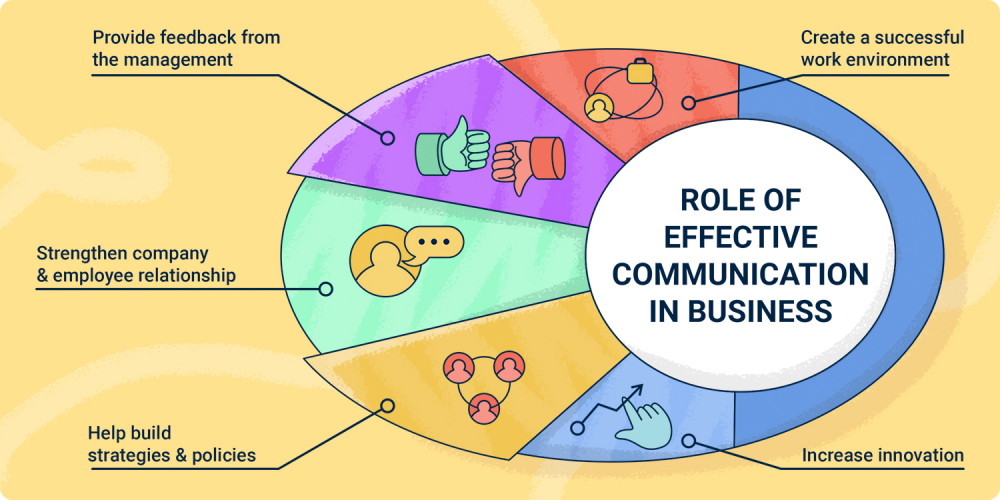
But with hundreds of communication skills business coaches recommend improving, how to identify the ones you should focus on first to get your company’s message across? You can start with addressing just 3 areas of communication to become an all-round communicator and spot these skills during the candidate search to build a team with a perfect skill set:
Let’s get into it!
1. Recognizing nonverbal cues
Despite the increased criticism in recent years that the 93/7 rule (93% of communication happening through body language/tone and 7% — through the use of words) is a big misunderstanding, you can’t deny that nonverbal elements are an integral part of every form of human interaction.
The way you behave nonverbally affects how others understand and perceive you.
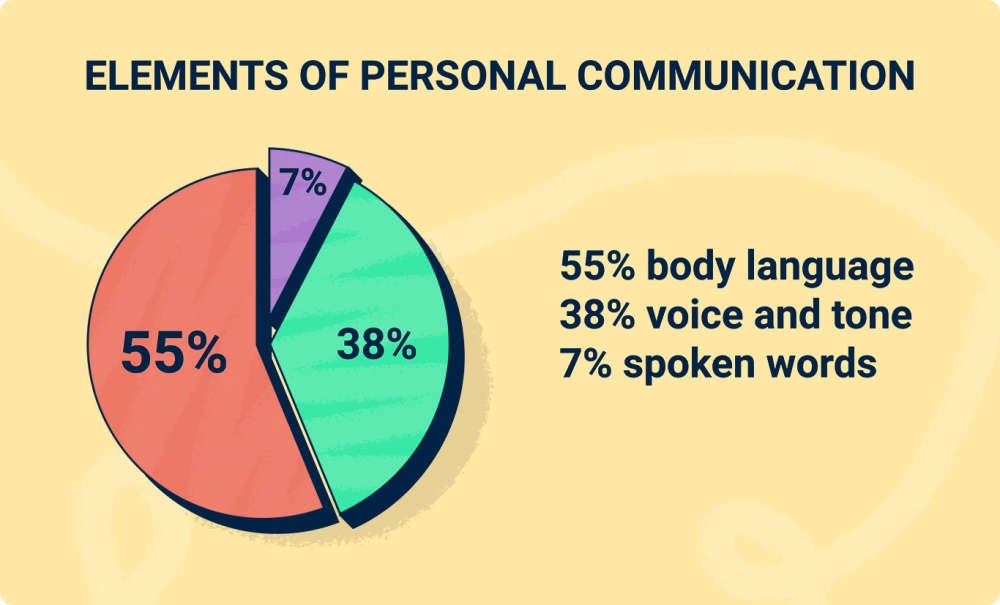
Nonverbal communication is a wordless type of communication that includes body language, facial expressions, hand movements, gestures, eye contact, appearance, tone of voice, and muscle tension, among others.
It allows us to express our genuine emotions and feelings, such as disappointment, relief, happiness, contentment, and more, far better than we can with words.
Understanding and using nonverbal signals can bring you closer to others, enabling you to express yourself, handle challenging situations, and improve your relationships at work.

What are some ways you can improve your nonverbal communication skills? Here are a few suggestions you can implement to improve your nonverbal communication skills in the workplace.
#1 Pick up on and interpret nonverbal cues
Reading body language is a talent that will take you a long time to master. But while everyone uses nonverbal communication in their own unique way, there are a few general indicators to look for that will reveal a person’s sentiments, intentions, motives, and more.
Let’s take a look at a few examples of nonverbal signals to pay attention to while communicating with your clients and colleagues:
- Facial expressions. If they are frowning, have a furrowed brow, or have tight lips, make sure they aren’t confused, upset, or experiencing other negative emotions.
- Posture. When their shoulders are back and their spine is straight, they’re engaged, actively listening, and open to the information you’re sharing. They may be tense, anxious, or angry if they have a lousy posture with their shoulders slouched or spine bent.
- Use of arms. When their arms are down by their sides or on the table, it indicates that they are confident and ready to hold a discussion with you. But if their arms are crossed or closed, something might be bothering them.
- Use of legs. If their feet are flat on the ground, it means they’re ready and willing to listen to your ideas. They may be uncomfortable or disturbed if their legs are crossed.
#2. Keep an eye out for nonverbal vs. verbal contradictions
Once you learn how to spot nonverbal clues, it will be easier for you to detect if a person’s words don’t match their nonverbal behavior. For example, someone might say they are happy while frowning and having their head down.
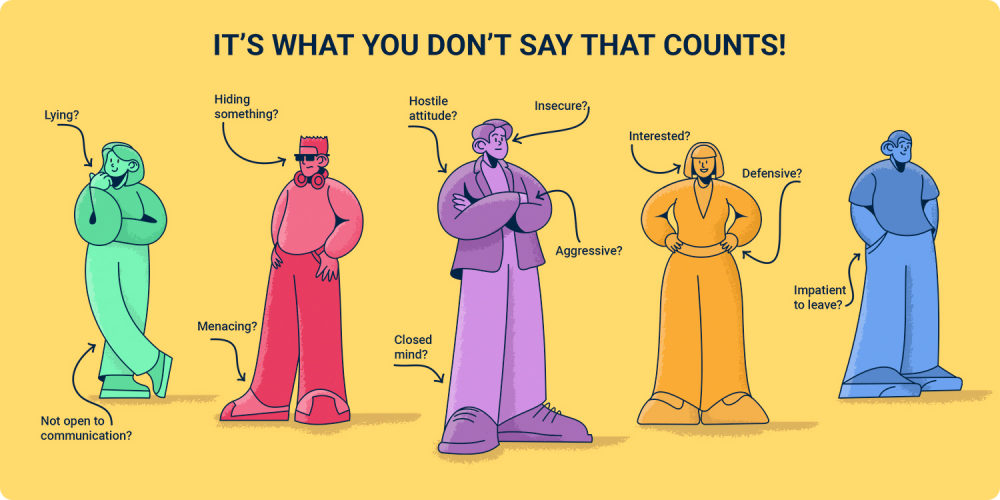
When words don’t match nonverbal signals, it’s better to disregard what has been stated and instead focus on subtle, unspoken moods, thoughts, and feelings. When a person says one thing, but their body language implies something different, it’s essential to pay attention to those nonverbal indications.
#3. Be aware of your tone of voice
It’s not just what you say but how you say it that counts. Your timing and pace, how loud you speak, your tone and intonation are all things people pay attention to. Your voice conveys everything from enthusiasm and confidence to boredom, sarcasm, and anger. So use it as an effective communication tool!
Become aware of how your tone affects your clients and colleagues and how others react to you, and try using your tone to clarify what you wish to communicate. For instance, if you’d like to demonstrate a genuine interest in something, use an animated tone of voice.

#4. Maintain eye contact
Many things can be said by how you look at a person, including affection, hatred, or attraction. Using eye contact to communicate your attention and interest is a highly effective technique.
Looking away from someone and down at the ground or your phone, for example, may imply disinterest or disrespect. On the other hand, excessive eye contact can be seen as aggressive. Remember that good eye contact doesn’t mean staring intensely into someone’s eyes despite the importance of eye contact in communication.
Is there a suitable amount of eye contact? Communication experts recommend holding eye contact for 4-5 seconds. The key here is to feel comfortable and natural when making eye contact with your conversation partner.
Maintaining eye contact is also vital for keeping the discussion flowing and measuring the other person’s interest and response.
#5. Ask questions
Don’t hesitate to ask questions if you’re confused by another person’s nonverbal signals. You can ask for an explanation by repeating what you believe was said. For example:
- “From what I understand, you are considering…”
- “In other words, you are saying…”
- “Are you suggesting we…”
Simply asking these questions can often shed light on the situation.
#6. Respect other people’s boundaries
Have you ever felt uneasy during a chat because someone was standing too close to you and invading your personal space? We all require boundaries, yet how much space we need varies depending on culture, situation, and the closeness of the relationship.
Physical space can be used to transmit a variety of nonverbal messages, including signals of intimacy and affection, hostility, and authority.
What we recommend is to remain within the 4-10 foot boundary.
#7. Use contextual cues not to misread nonverbal signals
Some believe that a firm handshake indicates strength, while a weak handshake indicates weakness. It’s possible to misinterpret this nonverbal signal, though! For instance, a weak handshake might indicate arthritis rather than weakness.
It’s essential to take a more comprehensive approach when analyzing nonverbal communication. One gesture can mean many things or nothing at all.
A key to understanding nonverbal behavior is to observe groups of signals linked to a common theme, which will tell you more about the person’s character than one signal in isolation. When focusing only on one signal out of several, you might have incorrect conclusions about what the other person is trying to communicate.
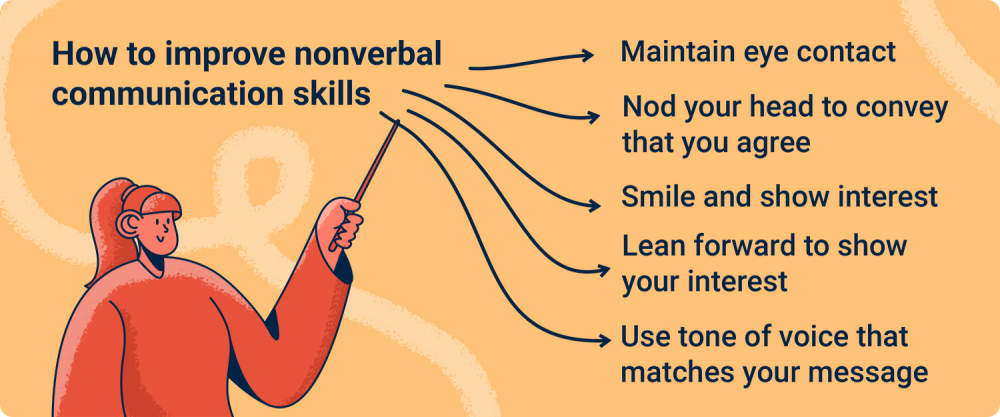
2. Practicing active listening
Communication is often misunderstood to mean only talking; however, active listening is key to business success.
You can gain more from conversations when you listen actively. It increases productivity, boosts confidence, and improves relationships with your clients and colleagues. It also allows you to expand your perspective by not attaching assumptions or biases to someone else’s message. Besides, you become more approachable and patient when actively listening to others.
Active listening stages
Understanding the stages of listening can help you improve your listening skills and business communications. Here’s what it includes:
- Receiving. First, receiving the speaker’s message entails separating it from all other noises and comprehending what was said. To guarantee that no information is lost during this stage, try not to think about anything else while the interlocutor is talking to you.
- Understanding. It’s at this stage that a message’s meaning can be misinterpreted. The most superb method to better understand what was said is to ask questions to fill in any information gaps. It’s also important to distinguish our own views and experiences from those of the interlocutor.
- Remembering. The first sign of passive listening is not remembering the message. More complex messages may be more difficult to understand or remember, so it might be helpful to associate them with something meaningful to you if you wish to record the information for later recall.
- Evaluating. This is where you decide whether the speaker’s information is well-constructed or disorganized, prejudiced or neutral, and accurate. Examine the speaker’s supporting points to see if they are valid and summarize what was said.
- Responding. At this stage, the listener responds based on short- or long-term memory. You can do it through nonverbal responses such as nodding or eye contact without interrupting the speaker. Or you can ask questions, take notes, or applaud — the goal is to show interest in the speaker by providing constant feedback.
Active listening skills
So how to become an active listener? There are 6 skills you need to put to practice: being attentive, asking open-ended questions, asking probing questions, clarifying, paraphrasing, and summarizing.
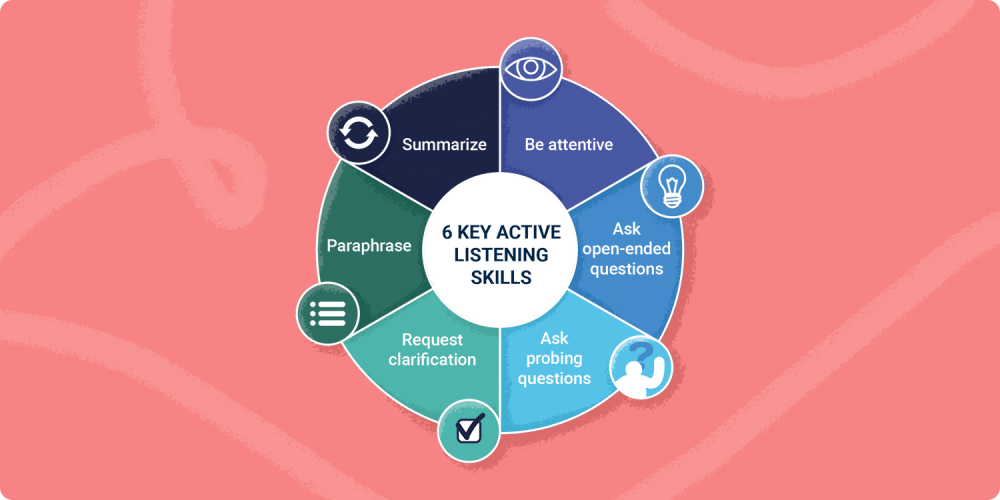
Let’s dive into them!
#1. Being attentive
Set a relaxed tone that allows the speaker to think and talk. Before replying, give yourself some wait time. Don’t interrupt whoever you’re talking to; their sentences should be completed, and you shouldn’t begin formulating your response before they have finished.
When practicing active listening, pay attention to your body language, as well as your mood. Focus on the present moment, maintain eye contact, and approach the interlocutor with respect.
#2. Asking open-ended questions
These questions require more than a simple “yes” or “no” answer and indicate to the speaker that you are paying attention and want to learn more:
- “How do you…?”
- “Can you tell me more about…?”
- “What are your thoughts about…?”
#3. Asking probing questions
Probing questions can be used to clarify or learn more about something that has already been said. Many of them are effective in building rapport, but you must be careful not to overuse them:
- “What does that mean?”
- “Can you explain why…?”
- “Why do you think this is the case?”
#4. Requesting clarification
When engaged in active listening, don’t be afraid to clarify any uncertain or unclear subject. If you’re the listener and unsure about what the speaker has said, say something like, “Let me see if I’m clear. Are you referring to…?” or “Wait a minute. I’m a bit lost.”
#5. Paraphrasing
Restate the same information more concisely, using alternative terms to test your understanding of what the speaker said:
- “What I’m hearing is…”
- “I’m not sure I’m with you, but…”
- “As you see it…”
#6. Summarizing
As the conversation progresses, summarizing what has been said confirms and deepens your understanding of the other person’s point of view. It also makes it easier for both parties to understand their joint duties and follow-up. While practicing active listening, summarize what you’ve learned and ask the other person to do the same.
3. Developing written communication skills
Communication through writing is always necessary regardless of your career field. Business communications, preparing reports, and reviewing written documents require strong writing skills.
Especially when sending emails!

Many people treat email as a less formal mode of communication than other methods because emailing has become a common way to communicate in both business and personal settings.
But emails should be treated as a written letter in a business context. So, when communicating in writing, be formal rather than friendly with your clients and coworkers. And since a permanent record of that communication is created when you write something down, make sure it’s a permanent record you are comfortable revisiting later.
Here are several quick tips to polish your business writing
Remember, you must make sure your written communications get your readers’ attention and ensure they get relevant information as quickly as possible.
- Don’t worry about perfection when you write your first draft.
- Review the draft afterward and correct any errors you find.
- Then repeat step 2. Continue doing this until you don’t find any errors. You can think of it as clearing boulders from an overgrown field. The boulders will be the first thing you notice. When you remove those, the rocks will appear. Next, you will see the pebbles. Keep writing until the field (your written product) is smooth.
- Reading your drafts aloud will significantly help you in reviewing and editing them. There is something fascinating about how obvious errors and inadequacies become when you listen to your draft instead of reading it silently.
- Use as few words as necessary to convey your message. Don’t use repeated words or trust-ruining phrases that don’t mean anything (e.g., “Just,” “To be honest,” It should be added,” etc.).
- Avoid generalizations. Be specific and brief, yet informative so that your audience can focus on only the most critical points.
- Follow-up is essential to good written communication, which closes the communication loop and demonstrates proactive action toward goals.
Business success depends on communication!
Communicating effectively with your colleagues will allow you to identify potential problems and implement solutions. By mastering your communication skills, you’ll learn more about every aspect of the business and be more aware of your colleagues’ concerns.
Besides being an excellent leader who directs difficult discussions effectively, good communicators must also be team players who acknowledge each worker’s role.
It’s okay if you don’t possess every business communication skill on this list. It takes time, experience, practice, and patience to master skills that aren’t second nature. Start by identifying which skills you lack the most, so you can create a plan to improve these skills and work smarter!
Good luck!

